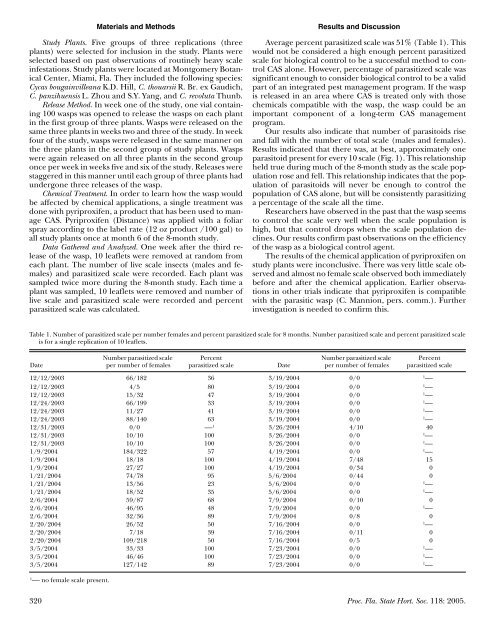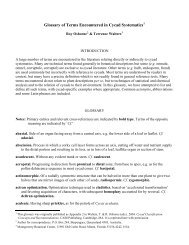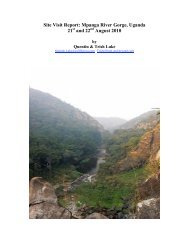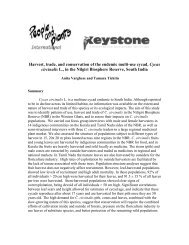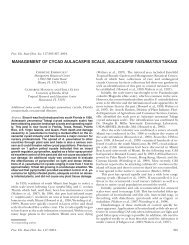effects of the parasitic wasp, coccobius fulvus - Cycad Specialist Group
effects of the parasitic wasp, coccobius fulvus - Cycad Specialist Group
effects of the parasitic wasp, coccobius fulvus - Cycad Specialist Group
Create successful ePaper yourself
Turn your PDF publications into a flip-book with our unique Google optimized e-Paper software.
320<br />
Materials and Methods<br />
Study Plants. Five groups <strong>of</strong> three replications (three<br />
plants) were selected for inclusion in <strong>the</strong> study. Plants were<br />
selected based on past observations <strong>of</strong> routinely heavy scale<br />
infestations. Study plants were located at Montgomery Botanical<br />
Center, Miami, Fla. They included <strong>the</strong> following species:<br />
Cycas bougainvilleana K.D. Hill, C. thouarsii R. Br. ex Gaudich,<br />
C. panzihuensis L. Zhou and S.Y. Yang, and C. revoluta Thunb.<br />
Release Method. In week one <strong>of</strong> <strong>the</strong> study, one vial containing<br />
100 <strong>wasp</strong>s was opened to release <strong>the</strong> <strong>wasp</strong>s on each plant<br />
in <strong>the</strong> first group <strong>of</strong> three plants. Wasps were released on <strong>the</strong><br />
same three plants in weeks two and three <strong>of</strong> <strong>the</strong> study. In week<br />
four <strong>of</strong> <strong>the</strong> study, <strong>wasp</strong>s were released in <strong>the</strong> same manner on<br />
<strong>the</strong> three plants in <strong>the</strong> second group <strong>of</strong> study plants. Wasps<br />
were again released on all three plants in <strong>the</strong> second group<br />
once per week in weeks five and six <strong>of</strong> <strong>the</strong> study. Releases were<br />
staggered in this manner until each group <strong>of</strong> three plants had<br />
undergone three releases <strong>of</strong> <strong>the</strong> <strong>wasp</strong>.<br />
Chemical Treatment. In order to learn how <strong>the</strong> <strong>wasp</strong> would<br />
be affected by chemical applications, a single treatment was<br />
done with pyriproxifen, a product that has been used to manage<br />
CAS. Pyriproxifen (Distance) was applied with a foliar<br />
spray according to <strong>the</strong> label rate (12 oz product /100 gal) to<br />
all study plants once at month 6 <strong>of</strong> <strong>the</strong> 8-month study.<br />
Data Ga<strong>the</strong>red and Analyzed. One week after <strong>the</strong> third release<br />
<strong>of</strong> <strong>the</strong> <strong>wasp</strong>, 10 leaflets were removed at random from<br />
each plant. The number <strong>of</strong> live scale insects (males and females)<br />
and parasitized scale were recorded. Each plant was<br />
sampled twice more during <strong>the</strong> 8-month study. Each time a<br />
plant was sampled, 10 leaflets were removed and number <strong>of</strong><br />
live scale and parasitized scale were recorded and percent<br />
parasitized scale was calculated.<br />
Results and Discussion<br />
Average percent parasitized scale was 51% (Table 1). This<br />
would not be considered a high enough percent parasitized<br />
scale for biological control to be a successful method to control<br />
CAS alone. However, percentage <strong>of</strong> parasitized scale was<br />
significant enough to consider biological control to be a valid<br />
part <strong>of</strong> an integrated pest management program. If <strong>the</strong> <strong>wasp</strong><br />
is released in an area where CAS is treated only with those<br />
chemicals compatible with <strong>the</strong> <strong>wasp</strong>, <strong>the</strong> <strong>wasp</strong> could be an<br />
important component <strong>of</strong> a long-term CAS management<br />
program.<br />
Our results also indicate that number <strong>of</strong> parasitoids rise<br />
and fall with <strong>the</strong> number <strong>of</strong> total scale (males and females).<br />
Results indicated that <strong>the</strong>re was, at best, approximately one<br />
parasitoid present for every 10 scale (Fig. 1). This relationship<br />
held true during much <strong>of</strong> <strong>the</strong> 8-month study as <strong>the</strong> scale population<br />
rose and fell. This relationship indicates that <strong>the</strong> population<br />
<strong>of</strong> parasitoids will never be enough to control <strong>the</strong><br />
population <strong>of</strong> CAS alone, but will be consistently parasitizing<br />
a percentage <strong>of</strong> <strong>the</strong> scale all <strong>the</strong> time.<br />
Researchers have observed in <strong>the</strong> past that <strong>the</strong> <strong>wasp</strong> seems<br />
to control <strong>the</strong> scale very well when <strong>the</strong> scale population is<br />
high, but that control drops when <strong>the</strong> scale population declines.<br />
Our results confirm past observations on <strong>the</strong> efficiency<br />
<strong>of</strong> <strong>the</strong> <strong>wasp</strong> as a biological control agent.<br />
The results <strong>of</strong> <strong>the</strong> chemical application <strong>of</strong> pyriproxifen on<br />
study plants were inconclusive. There was very little scale observed<br />
and almost no female scale observed both immediately<br />
before and after <strong>the</strong> chemical application. Earlier observations<br />
in o<strong>the</strong>r trials indicate that pyriproxifen is compatible<br />
with <strong>the</strong> <strong>parasitic</strong> <strong>wasp</strong> (C. Mannion, pers. comm.). Fur<strong>the</strong>r<br />
investigation is needed to confirm this.<br />
Table 1. Number <strong>of</strong> parasitized scale per number females and percent parasitized scale for 8 months. Number parasitized scale and percent parasitized scale<br />
is for a single replication <strong>of</strong> 10 leaflets.<br />
Date<br />
Number parasitized scale<br />
per number <strong>of</strong> females<br />
Percent<br />
parasitized scale Date<br />
Number parasitized scale<br />
per number <strong>of</strong> females<br />
Percent<br />
parasitized scale<br />
12/12/2003 66/182 36 3/19/2004 0/0<br />
1-----<br />
12/12/2003 4/5 80 3/19/2004 0/0<br />
1-----<br />
12/12/2003 15/32 47 3/19/2004 0/0<br />
1-----<br />
12/24/2003 66/199 33 3/19/2004 0/0<br />
1-----<br />
12/24/2003 11/27 41 3/19/2004 0/0<br />
1-----<br />
12/24/2003 88/140 63 3/19/2004 0/0<br />
1-----<br />
12/31/2003 0/0 -----1<br />
3/26/2004 4/10 40<br />
12/31/2003 10/10 100 3/26/2004 0/0<br />
1-----<br />
12/31/2003 10/10 100 3/26/2004 0/0<br />
1-----<br />
1/9/2004 184/322 57 4/19/2004 0/0<br />
1-----<br />
1/9/2004 18/18 100 4/19/2004 7/48 15<br />
1/9/2004 27/27 100 4/19/2004 0/34 0<br />
1/21/2004 74/78 95 5/6/2004 0/44 0<br />
1/21/2004 13/56 23 5/6/2004 0/0<br />
1-----<br />
1/21/2004 18/52 35 5/6/2004 0/0<br />
1-----<br />
2/6/2004 59/87 68 7/9/2004 0/10 0<br />
2/6/2004 46/95 48 7/9/2004 0/0<br />
1-----<br />
2/6/2004 32/36 89 7/9/2004 0/8 0<br />
2/20/2004 26/52 50 7/16/2004 0/0<br />
1-----<br />
2/20/2004 7/18 39 7/16/2004 0/11 0<br />
2/20/2004 109/218 50 7/16/2004 0/5 0<br />
3/5/2004 33/33 100 7/23/2004 0/0<br />
1-----<br />
3/5/2004 46/46 100 7/23/2004 0/0<br />
1-----<br />
3/5/2004 127/142 89 7/23/2004 0/0<br />
1-----<br />
1-----<br />
no female scale present.<br />
Proc. Fla. State Hort. Soc. 118: 2005.


